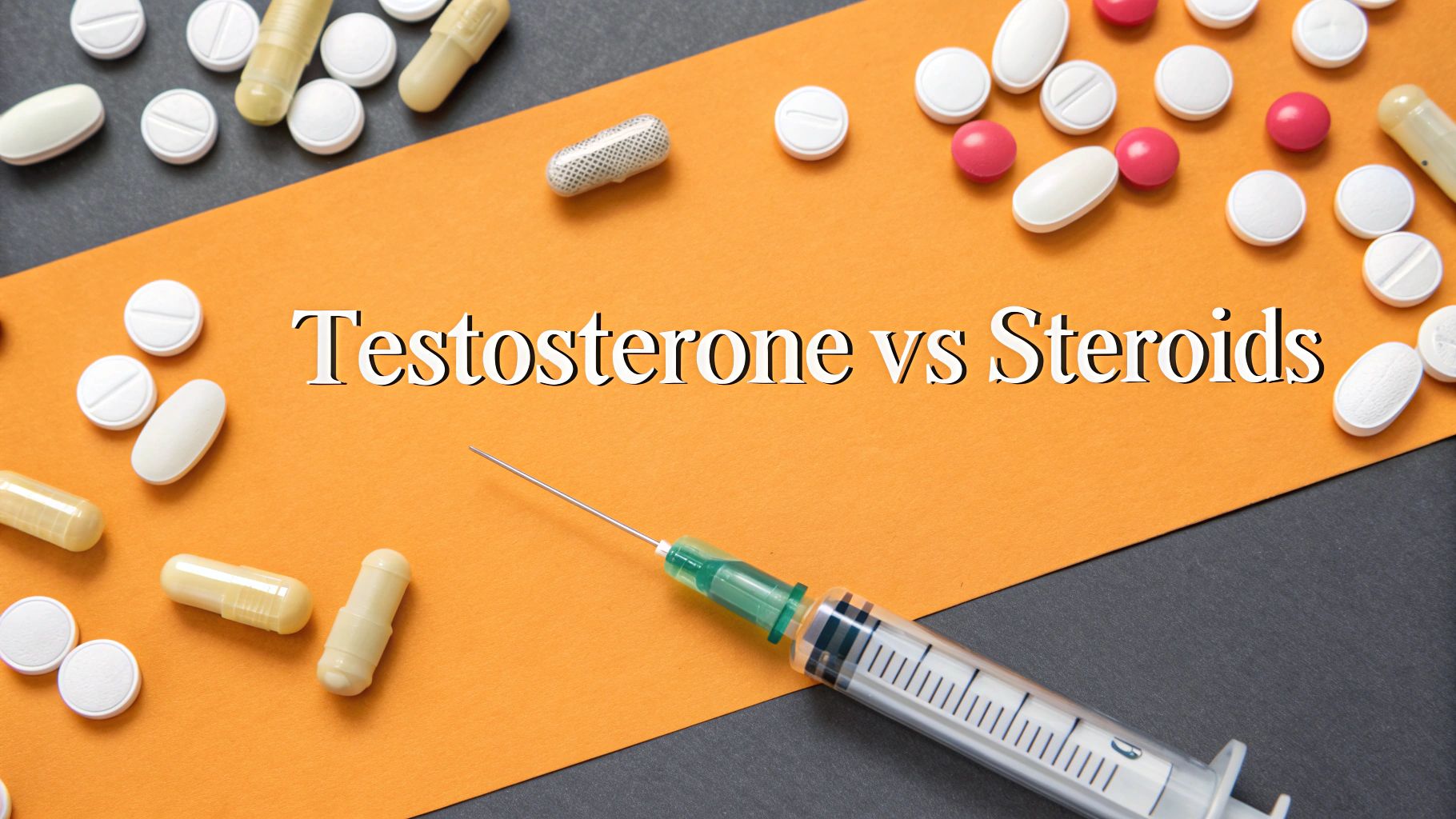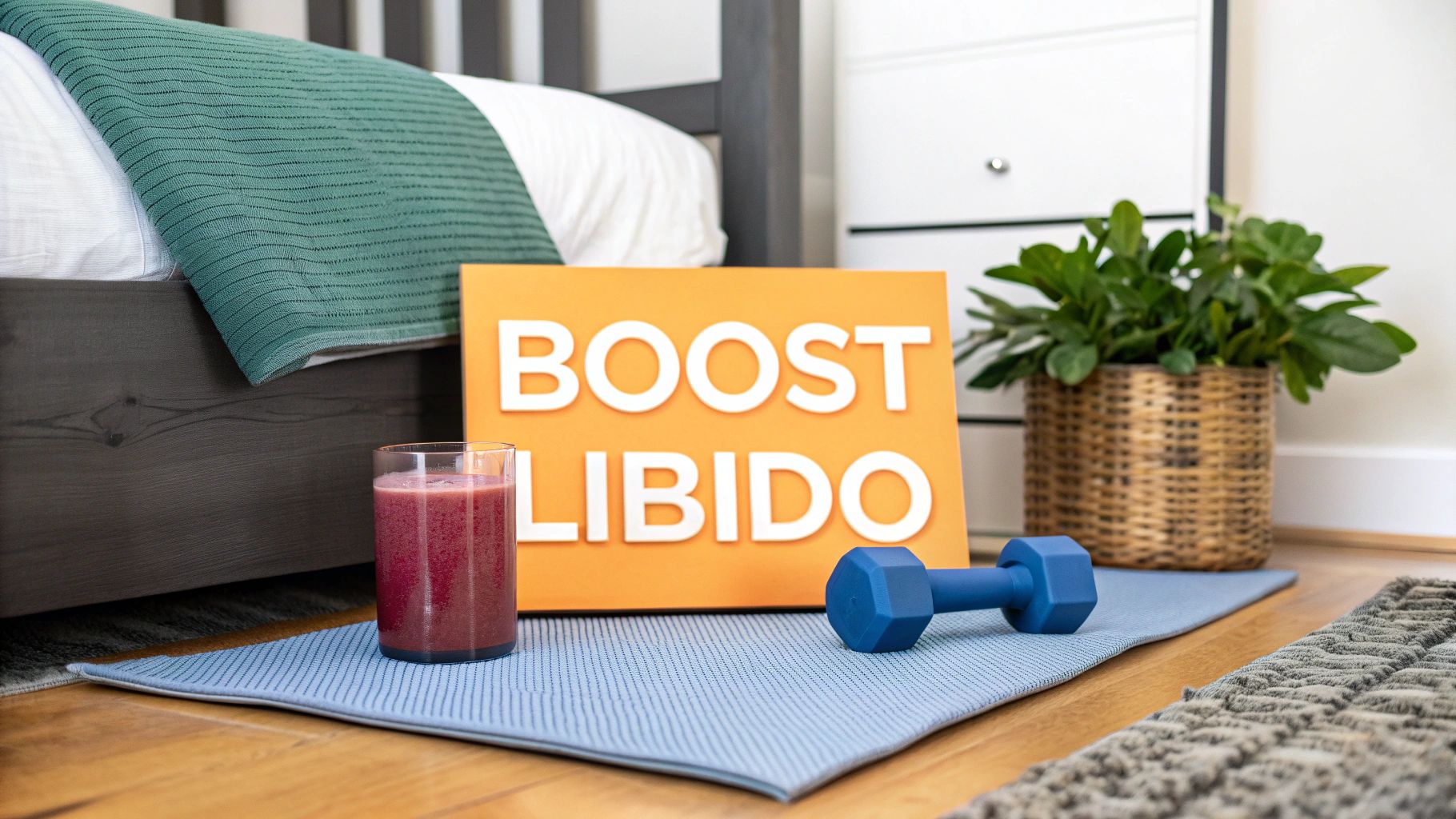Deciding to start testosterone replacement therapy (TRT) is a big step, and one of the first things you'll discuss with your doctor is how you'll take it. The main options on the table are injections, gels, patches, pellets, oral tablets, and even nasal sprays.
Each method delivers testosterone in a completely different way, which directly impacts everything from your daily routine and budget to how stable your hormone levels will be. The right choice isn't about what's "best" in general, but what works best for your life, your preferences, and your body.

Understanding Your TRT Choices
Choosing the right TRT method is a balancing act between medical effectiveness and real-world practicality. Testosterone is the cornerstone hormone for male vitality, governing your libido, muscle mass, bone density, and mood. When those levels drop—whether from age or an underlying condition—the symptoms can seriously get in the way of your quality of life.
TRT is all about restoring those levels, but the "how" really matters. Some guys don't mind a daily application, finding it easy to work into their morning routine. Others would much rather have a long-acting solution they can mostly forget about for months at a time. There's no single perfect option—just the one that fits you.
Why Are There So Many Options?
The demand for effective TRT has exploded in recent years. A big reason is a better understanding of hypogonadism, the clinical term for when the body just doesn't produce enough testosterone on its own. It's more common than you might think; in the United States, an estimated 13 million men—or about 1 in 4 over the age of 30—are dealing with low T.
This growing awareness has driven huge innovation. The global TRT market was valued at around $2.03 billion in 2024 and is expected to keep climbing. That growth has pushed the development of more diverse and sophisticated delivery systems, giving you and your doctor more choices than ever.
While TRT is a powerful medical tool, it's also worth knowing about lifestyle changes that can help. For those curious, we have a great guide on science-based secrets to boosting testosterone levels.
At-a-Glance Comparison of TRT Methods
To give you a bird's-eye view of your options, we've put together a quick summary table. This breaks down the core pros, cons, and what to expect from the most common testosterone replacement therapy methods. It's a great starting point for your conversation with your doctor.
"The form of testosterone we ultimately decide upon involves shared decision-making with the patient based on their goals and preferences. It's a conversation between you and your healthcare provider to find the perfect fit."
Use this table to get familiar with the landscape.
| Method | Application Frequency | Key Advantage | Key Disadvantage |
|---|---|---|---|
| Injections | Weekly or Bi-weekly | Highly effective and low cost | Requires needles; can cause hormone fluctuations |
| Gels | Daily | Easy, non-invasive application | Risk of transference to others (women/children) |
| Patches | Daily | Simple to use and apply | Can cause skin irritation; may fall off |
| Pellets | Every 3-6 months | Very convenient; "set it and forget it" | Requires a minor in-office surgical procedure |
| Oral Tablets | Daily or Twice Daily | Avoids needles and skin application | Newer option; potential for absorption variability |
| Nasal Spray | Multiple times per day | No risk of skin transference | Frequent dosing can be inconvenient |
This high-level overview gives you a solid foundation. In the following sections, we'll dive much deeper into each of these methods, giving you the detailed pros and cons you need to make a confident decision.
Comparing TRT Methods Side by Side
Choosing your TRT method is the single most important decision you and your doctor will make. This isn't just about what seems easiest; it's about matching a specific medical delivery system to your unique body, lifestyle, and budget. Each option—from weekly injections to long-lasting pellets—comes with its own distinct set of pros and cons that go well beyond simple convenience.
To make the right call, we have to look at how each one stacks up across the things that actually matter. We’ll break down their ability to keep your hormone levels steady, how they fit into a real-world routine, what they typically cost each month, and the specific side effects most commonly tied to each one.
Hormone Stability: The Cornerstone of Effective TRT
The entire point of TRT is to get your testosterone levels back into a healthy, stable range and keep them there. Big swings in your hormone levels can create a rollercoaster of symptoms, making you feel great for a few days before crashing hard. That completely defeats the purpose of the therapy.
- Testosterone Injections: This method is notorious for creating "peaks and troughs." Your T levels can spike right after the shot and then steadily decline, often dipping below the optimal range just before your next dose is due. More frequent, smaller injections can definitely help smooth out these fluctuations.
- Topical Gels: When you apply a gel every day, you get a much more stable, day-to-day level of testosterone. The skin absorbs the hormone slowly, creating a consistent release into your bloodstream that avoids the dramatic highs and lows you see with less frequent dosing.
- Patches: Like gels, patches are made for steady, daily hormone delivery. However, real-world factors like sweat, skin type, or the patch not sticking well can sometimes lead to inconsistent absorption and fluctuating levels.
- Pellets: When it comes to stability, pellets are the gold standard. Once implanted, they release a very slow, consistent dose of testosterone over several months. This closely mimics how the body naturally produces hormones and gets rid of daily or weekly ups and downs.
The "best" option is often a direct trade-off between convenience and hormonal stability. While pellets give you the steadiest levels, injections offer the flexibility to easily tweak your dose—a huge advantage when you're first starting treatment and dialing everything in.
Administration Convenience and Lifestyle Fit
How easily a therapy slots into your daily life is just as critical as its medical effectiveness. If the routine is a hassle, you're more likely to miss doses, which torpedoes your results.
Testosterone Injections
Injections are usually done once or twice a week. While that’s less frequent than daily options, it means you have to be comfortable with needles and use proper sterile technique. Many guys learn to do it themselves at home, but others would rather just pop into a clinic.
Topical Gels and Patches
Gels and patches are non-invasive and applied daily. Most people see this as super convenient, making it part of a morning routine like brushing your teeth. The main downside is that you can't miss a day, and you have to take care to prevent transferring it to others.
Testosterone Pellets
For anyone looking for a "set it and forget it" approach, pellets are in a class of their own. You only need a minor in-office procedure every 3-6 months, which frees you from thinking about your therapy on a daily or weekly basis.
This infographic gives a general overview of the balance between the benefits you can expect from a well-managed TRT plan versus the potential risks.

The chart clearly shows that while the benefits like better libido and more muscle mass are substantial, the rate of significant side effects is relatively low. This highlights the therapy's strong risk-to-benefit ratio when it's medically supervised.
Detailed Breakdown of Testosterone Therapy Options
To help you really dig in and weigh these factors, the table below gives a direct, side-by-side comparison of the most common TRT options. It lays out the key differences in hormone stability, cost, convenience, and the primary risks tied to each one.
| TRT Option | Hormone Level Stability | Monthly Cost (Estimate) | Convenience Factor | Primary Side Effect Concern |
|---|---|---|---|---|
| Injections | Moderate (peaks/troughs) | $30 – $100 | Low (weekly/bi-weekly needles) | Mood swings from hormone fluctuations |
| Gels | High (stable daily levels) | $200 – $500 | High (easy daily application) | Risk of transference to others |
| Patches | High (stable if adherent) | $200 – $500 | Medium (daily but can irritate skin) | Skin irritation or allergic reactions |
| Pellets | Very High (most stable) | $500 – $800 (per procedure) | Very High (every 3-6 months) | Site infection or pellet extrusion |
| Oral | Moderate to High | $200 – $400 | High (daily pill) | Absorption variability; needs specific food intake |
This table makes the trade-offs crystal clear. For example, the low cost and proven effectiveness of injections are balanced against their less stable hormone delivery. On the flip side, the incredible convenience and stability of pellets come with a much higher price tag. If you're comparing oral medication to injections, you can get more details by checking out our deep dive into the testosterone oral vs injection debate.
Weighing the Primary Risks
Every medical treatment comes with potential side effects, and TRT is no different. But the most common risk you'll face is often tied directly to the delivery method you choose.
- Gels and Transference: The biggest worry with topical gels is accidental transference. If a partner, child, or even a pet touches the application site before it’s completely dry, they can absorb the testosterone. This can be very dangerous for them.
- Injections and Fluctuations: The main "risk" with injections comes from the hormonal cycle itself. The initial spike can sometimes trigger acne or moodiness, while the trough before your next shot can bring back low T symptoms like fatigue and brain fog.
- Patches and Skin Irritation: A surprisingly high number of users—sometimes up to 30%—report skin irritation, redness, or rashes where the patch is applied. For guys with sensitive skin, this can be a total deal-breaker.
- Pellets and Procedure Risks: Although it's a minor procedure, implanting pellets is still a surgical act. Because of that, it carries a small risk of infection, bleeding, or the pellet working its way out of the skin (a process called extrusion).
Understanding these subtle but important differences is what allows you to have a genuinely productive conversation with your doctor. When you know the detailed profiles of the different TRT options, you're better equipped to advocate for the solution that truly fits your health goals, your lifestyle, and your personal comfort level.
Matching a TRT Option to Your Lifestyle

Choosing the right TRT method goes way beyond a clinical list of pros and cons. The best treatment for you is the one that actually fits into your life without causing headaches. A therapy might be medically perfect, but if it's a practical nightmare, it’s not going to stick.
This is where we move past the lab and into the real world. Your day-to-day reality—whether you're constantly on the road, hate needles, or have young kids running around—is the most critical factor. By looking at how each TRT option stacks up against these common life scenarios, you can figure out which one will support your goals, not complicate them.
For the Frequent Traveler or Busy Professional
If your life is a blur of airports, hotels, and back-to-back meetings, you need a treatment that’s simple and low-maintenance. The last thing you want to worry about is packing syringes or finding a private moment for a messy gel application.
Best Fit: Testosterone Pellets
Pellets are the definition of "set it and forget it." After a quick, in-office procedure, you get a steady stream of testosterone for 3-6 months. No daily reminders, no packing extra supplies for a business trip, and no stressing about application times.
Less Ideal: Gels and Nasal Sprays
Daily gels demand a consistent routine and careful handling to prevent transferring them to others. Nasal sprays are even more of a hassle, often needing multiple doses throughout the day. For someone jumping time zones or racing between appointments, these options are just too hard to manage effectively.
For the Man with a Needle Phobia
Let's be real: a lot of guys have a genuine fear of needles. If the thought of self-injections makes you break out in a cold sweat, that’s a major roadblock. The good news is, you have excellent, non-invasive options.
Best Fit: Patches or Oral Tablets
Topical patches and oral tablets like Jatenzo offer a completely needle-free experience. You either stick a patch on your skin daily or simply take a pill. Both are straightforward methods to get your testosterone without the anxiety that comes with injections.
Less Ideal: Injections
This one’s obvious. If you have a true needle phobia, weekly self-injections are a non-starter. Even if you go to a clinic to have a nurse do it, the mental stress can still be a huge negative and sabotage your commitment to the therapy.
A core principle of successful TRT is adherence. If a specific delivery method causes you anxiety or stress, your likelihood of consistently following the treatment plan decreases, ultimately undermining your results. Choosing a method you are comfortable with is non-negotiable.
For the Man with a Partner or Young Children at Home
When you live with other people—especially a partner or kids—the risk of accidentally transferring testosterone becomes a serious issue. With some topical methods, this is a primary concern you can't afford to ignore.
Best Fit: Injections, Pellets, or Oral Tablets
These methods are totally self-contained. Because the testosterone is delivered directly inside your body, there's zero risk of it rubbing off on anyone else. For men with families, this gives you complete peace of mind.
Less Ideal: Topical Gels
Gels carry the highest risk of transference. The hormone can easily spread through skin-to-skin contact, unwashed clothes, or even bedsheets if you aren't extremely careful. If you have kids who love to hug or an intimate partner, the potential danger usually isn't worth the convenience.
Comparing Options for Specific Lifestyles
To make this even clearer, let's break down a few more real-world scenarios and see which TRT methods make the most sense.
| Lifestyle Scenario | Primary Goal | Recommended TRT Option | Why It Works |
|---|---|---|---|
| Active Gym-Goer | Consistency despite sweat | Injections or Pellets | Patches can peel off with excessive sweating. Injections and pellets are completely unaffected by your workout routine. |
| Budget-Conscious Individual | Cost-effectiveness | Testosterone Injections | This is generally the most affordable TRT option, especially if you self-administer at home. |
| Man with Sensitive Skin | Avoid skin irritation | Injections, Gels, or Pellets | Patches are known for causing skin reactions, with up to 30% of users reporting some level of irritation. |
| Person Desiring Dosing Flexibility | Ability to adjust dose easily | Injections or Gels | These methods let you and your doctor fine-tune your dose quickly, which is perfect when you're just starting out. |
In the end, choosing a TRT method is a team decision between you and your doctor. By thinking through these practical situations ahead of time, you can walk into that conversation with a much clearer picture of what you truly need. This helps you advocate for a solution that not only works medically but also works for your life.
How Innovation Is Shaping Modern TRT

The world of testosterone replacement therapy is evolving fast, moving far beyond the one-size-fits-all methods that were standard for decades. What’s driving this shift? A clear demand from patients for treatments that are more convenient, effective, and fit seamlessly into their lives. The medical community is listening and responding with some pretty significant improvements.
This isn't just about dreaming up new drugs. It’s about completely rethinking how TRT is delivered and managed. The end goal is to make therapy safer, more accessible, and fine-tuned to deliver consistent, predictable results for every man. This forward momentum is why the testosterone replacement therapy options of tomorrow will be even better than what we have today.
The Rise of Telemedicine and Remote Care
One of the biggest game-changers in TRT management has been the arrival of telemedicine. Gone are the days when every single consultation, lab review, or dosage tweak meant a trip to the doctor's office. Now, secure digital platforms connect patients with specialists right from the comfort of their own homes.
This model has blown the doors open on accessibility, especially for men living in rural areas or juggling demanding schedules. Through remote monitoring and virtual check-ins, doctors can track a patient’s progress, adjust dosages based on real-time feedback, and make sure the therapy stays both effective and safe.
The convenience of telemedicine has fundamentally changed the patient experience. It empowers men to take a more active role in their health by removing common barriers to consistent, high-quality medical supervision.
This move toward remote care is backed by serious market growth. The global TRT market was valued at USD 1.89 billion in 2024 and is projected to hit nearly USD 2.7 billion by 2032. A huge piece of this is the growing awareness of hypogonadism, which is driving demand for better treatments. You can get a closer look at the research on the TRT market transformation from PR Newswire.
Advanced Formulations and Delivery Systems
It's not just how care is managed that's improving; the treatments themselves are getting a major upgrade. Pharmaceutical research is laser-focused on creating new formulations that offer a better user experience and, most importantly, more stable hormone delivery.
Here are a few key areas getting a lot of attention:
- Longer-Lasting Injections: Researchers are exploring new ester formulations to stretch out the time between injections. This means less frequent dosing while keeping testosterone levels steady and avoiding the hormonal rollercoaster.
- Improved Oral Options: The latest oral tablets are engineered to bypass the liver, sidestepping the toxicity concerns that plagued older pills. This provides a reliable, needle-free alternative with predictable absorption.
- Next-Generation Topicals: The focus here is on gels and patches that absorb more efficiently and dry faster. The goal is to minimize skin irritation and reduce the risk of accidentally transferring the hormone to others.
Big pharma players like AbbVie and Eli Lilly are at the forefront of this innovation, constantly refining delivery systems to make therapy feel less like a chore. The future might even bring AI-driven tools that analyze patient data to pinpoint the perfect TRT method and dose, paving the way for truly personalized treatment plans. This relentless drive for improvement guarantees that the list of testosterone replacement therapy options will only get better and longer.
Preparing to Discuss TRT With Your Doctor
Deciding to explore testosterone replacement therapy is a big step. But the real work begins with having a productive, well-informed conversation with your doctor. Walking into that appointment prepared doesn't just help your provider give you the best advice; it empowers you to be an active partner in your own healthcare.
The goal isn't just to walk out with a prescription. It's to build a collaborative plan that's safe, effective, and actually fits into your life. This means going beyond simply saying, "I think I have low T." A successful consultation depends on you being able to describe your specific symptoms, understand your own health history, and have a clear idea of what you want to achieve with treatment. Your doctor will take that information and combine it with hard data from blood tests to map out the best path forward.
Arming Yourself With the Right Questions
To really get the most out of your appointment, you need to ask targeted questions that get into the nuts and bolts of TRT. Don't be shy about digging into the details—this is your health, and you need to understand the process inside and out. Being prepared ensures no stone is left unturned.
Here are a few essential questions to have ready:
- How often will we need to do blood tests? Consistent monitoring is the only way to track your testosterone levels and other key health markers.
- What side effects should I be most concerned about? Get specific. Ask about monitoring for things like polycythemia (a spike in red blood cells) and changes in your cholesterol.
- How will we manage any side effects if they show up? Knowing there’s a plan in place from the start offers critical peace of mind.
- Based on my goals, which therapy makes the most sense? Be clear about whether you're prioritizing energy, libido, muscle mass, or mood.
Your first conversation with your doctor sets the tone for your entire treatment journey. Being prepared with clear goals and thoughtful questions ensures you and your provider are aligned from day one, which is the foundation of a successful outcome.
Creating Your Personal TRT Checklist
Before you head to the doctor's office, take some time to think about your own situation. Every man is different, and these personal details will heavily influence which of the testosterone replacement therapy options is the right fit. This isn't just a medical decision; it's a lifestyle one, too.
Your checklist should hit these four core areas:
- Your Primary Goals: What are the top 1-3 symptoms you're hoping to fix? Is your main priority boosting your energy for work, firing up your libido, or getting back the muscle you've lost in the gym?
- Your Health History: Be ready to talk about any pre-existing conditions. Do you have a history of heart problems, sleep apnea, or any prostate concerns? Total honesty here is non-negotiable for your safety.
- Your Lifestyle Needs: Think about your day-to-day. Do you travel a lot? Are you okay with needles? Do you have small kids or a partner at home where transference from a gel could be a real problem?
- Your Budget: The costs of TRT can swing wildly from one method to another. You can learn more by reading about the average cost of testosterone replacement therapy to get a clearer picture of the financial commitment for each option.
By thinking through these points ahead of time, you give your doctor the full picture. This allows them to go beyond a generic recommendation and help you land on a therapy that is both medically sound and practically sustainable for you. This collaborative approach is the surest way to find a treatment that doesn't just raise your numbers, but genuinely improves your quality of life.
Common Questions About TRT
Even after you've explored all the different ways to take testosterone, it's completely normal to have some practical questions about what comes next. Knowing the day-to-day realities of treatment is the key to feeling confident and ready. Here, we tackle some of the most common questions guys have when they're about to start TRT.
Getting straight, clear answers helps you manage your expectations and makes the whole process feel smoother. From when you'll feel a difference to whether your insurance will chip in, getting these details sorted out can make a huge difference in your experience.
How Long Until I Actually Feel the Effects of TRT?
This is one of the first things almost every man asks, and the honest answer is: it varies. While some guys report feeling subtle improvements in just a few weeks, the full benefits of TRT don't happen overnight. You won't wake up one morning feeling like a brand-new person; the changes are gradual and build over time.
A typical timeline for benefits looks something like this:
- Libido and Sexual Interest: This is often one of the first things to get better, usually within 3-6 weeks.
- Energy and Mood: You might start noticing real shifts in your energy levels, motivation, and overall sense of well-being around the one-month mark, with steady improvement over the next three months.
- Muscle Mass and Body Composition: Changes in muscle strength and a drop in body fat take longer. You'll likely see results you can measure after 3-6 months of consistent therapy, especially if you’re also dialing in your diet and exercise.
Patience is everything here. Your body needs time to adjust to having stable hormone levels again, and sticking with your treatment consistently is the single most important thing you can do to see results.
Can I Switch TRT Methods if One Isn't Working for Me?
Absolutely. In fact, it's pretty common for patients to start with one method and later decide another one is a better fit for their lifestyle. What sounds convenient on paper might not work out in the real world, and that’s perfectly fine. For example, a man might start with daily gels but find the constant worry about transferring it to his family is too stressful, leading him to switch to injections.
The best TRT option is the one you can actually stick with consistently and comfortably. If your current method is a source of stress, irritation, or just plain inconvenience, switching isn't just possible—it's a smart move for long-term success.
The process of switching is straightforward. You’ll just have a conversation with your doctor about why your current method isn't a good fit and decide on a new one. Your provider will then walk you through how to make the transition safely, which might involve a specific timing for the switch to keep your hormone levels stable.
What Blood Tests Are Most Important to Track?
Consistent monitoring with blood work is the cornerstone of safe and effective TRT. While your doctor will order a full panel, there are a few key markers that are especially critical to watch throughout your treatment.
These tests make sure your hormone levels are in the optimal range and that your body is responding well to therapy without any unwanted side effects. The most vital tests include:
- Total and Free Testosterone: This measures your overall testosterone and, more importantly, the amount of "bioavailable" testosterone your body can actually put to use.
- Estradiol (E2): Testosterone can convert into estrogen. Keeping an eye on estradiol is essential to head off side effects like moodiness or gynecomastia (enlargement of breast tissue).
- Complete Blood Count (CBC): This is crucial for watching your hematocrit and hemoglobin. TRT can sometimes thicken the blood by increasing red blood cell production (a condition called polycythemia), which needs to be managed to avoid cardiovascular risks.
- Prostate-Specific Antigen (PSA): This test is done to monitor the health of your prostate, as TRT can have an effect on it.
Does Insurance Typically Cover TRT?
Insurance coverage for TRT can be a real mixed bag and usually hinges on a strict clinical diagnosis. Most insurance companies will only even consider covering treatment if you have a confirmed diagnosis of hypogonadism. This generally means you need at least two separate morning blood tests showing testosterone levels below 300 ng/dL, along with documented symptoms.
If you meet these tough criteria, many plans will cover a portion of the cost, particularly for older, more established methods like injections. However, newer or more expensive options like pellets or some oral tablets might require a fight for prior authorization or may not be covered at all. Your best bet is to call your insurance provider directly to understand exactly what your policy requires and covers before you start treatment.
At Elite Bioscience, we clear the path to optimized health by giving you direct access to premium, third-party-tested hormone and peptide therapies. Our secure platform connects you with experienced medical professionals who will design a plan that fits your goals, with discreet delivery right to your door. Take control of your well-being and explore your options with us today at https://elitebioscience.co.







